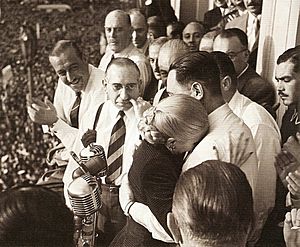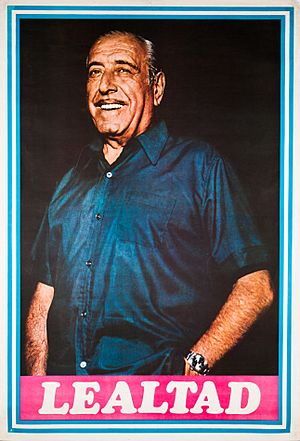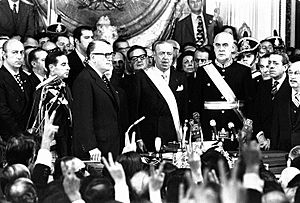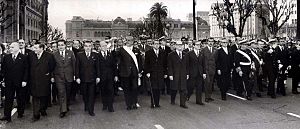Héctor José Cámpora facts for kids
Quick facts for kids
Héctor Cámpora
|
|
|---|---|
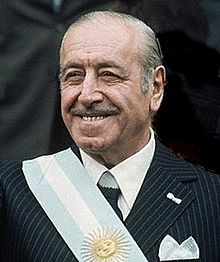
Campora in 1973
|
|
| President of Argentina | |
| In office 25 May 1973 – 12 July 1973 |
|
| Vice President | Vicente Solano Lima |
| Preceded by | Alejandro Agustín Lanusse (de facto) |
| Succeeded by | Raúl Alberto Lastiri (interim) |
| President of the Chamber of Deputies | |
| In office 26 April 1948 – 26 April 1953 |
|
| Preceded by | Ricardo Guardo |
| Succeeded by | Antonio J. Benítez |
| National Deputy | |
| In office 4 June 1946 – 16 September 1955 |
|
| Constituency | Buenos Aires (1946–1952) Buenos Aires's 24th circonscription (1952–1955) |
| Personal details | |
| Born |
Héctor José Cámpora
26 March 1909 Mercedes, Argentina |
| Died | 18 December 1980 (aged 71) Cuernavaca, Mexico |
| Political party | Justicialist |
| Spouse | María Georgina Cecilia Acevedo |
| Profession | Dentist |
| Signature |  |
Héctor José Cámpora (born March 26, 1909 – died December 18, 1980) was an important Argentine politician. He was a key leader in a political movement called Peronism. Cámpora served briefly as the President of Argentina from May 25 to July 13, 1973. He helped arrange for Juan Perón to run for president, who then won the election. A modern youth group in Argentina, La Cámpora, is named after him. Before becoming a politician, he worked as a dentist.
Contents
Early Life and Education
Cámpora was born on March 26, 1909. His full name was Héctor José Cámpora Demaestre. He was born in the city of Mercedes, Buenos Aires, in the Buenos Aires Province. People sometimes called him el Tío, which means "the Uncle."
He studied dentistry at the University of Córdoba, Argentina. After finishing his studies, he worked as a dentist in his hometown. Later, he moved to a nearby town called San Andrés de Giles.
Political Career Begins
Cámpora first met General Juan Perón in 1944. Perón was the minister of labor at the time. When Perón became president in 1946, Cámpora entered politics.
He was elected to the Argentine Chamber of Deputies, which is like a house of representatives. He led this group from 1948 to 1952. In 1953, he traveled to 17 countries as a special ambassador.
In 1955, Perón's government was overthrown. Cámpora was arrested and faced charges. He managed to leave the country in 1956. He returned three years later when the charges against him were dropped.
Road to the Presidency
In 1971, Juan Perón chose Cámpora as his "personal delegate." This meant Cámpora represented Perón. At the time, Perón was not allowed to run for president by the military government. General Alejandro Agustín Lanusse was the dictator then.
So, Cámpora ran for president in 1973 instead. His running mate was Vicente Solano Lima. Cámpora was known for his left-leaning views. However, Solano Lima belonged to a more conservative party.
Cámpora won the March 1973 Argentine general election with almost 50% of the votes. The leader of the Radical Civic Union, Ricardo Balbín, came in second. Balbín chose to accept his defeat. This helped avoid a political crisis.
Cámpora as President
Cámpora became president on May 25, 1973. Leaders from other countries, like Chilean President Salvador Allende, were there. About a million people gathered in the Plaza de Mayo to celebrate the new president.
One of Cámpora's first actions was to release people who had been imprisoned for political reasons. On May 28, Argentina also started diplomatic relations with Cuba again. Argentina then sent aid to Cuba, like food and industrial goods. This helped Cuba during a trade ban from the United States.
During Cámpora's time in office, there were many protests and worker strikes. Workers also took over factories. Some revolutionary groups stopped using violence. This worried some right-wing groups within Peronism.
Cámpora's political ideas were different from the right-wing parts of Peronism. When Juan Perón returned to Argentina on June 20, 1973, there was fighting between different Peronist groups. This happened at the main airport. Perón's plane had to land at a military airport instead. This event is known as the Ezeiza Massacre.
José Ber Gelbard became the minister of economics. He tried to create a "social pact" between workers and businesses. This plan included setting prices and raising salaries for workers.
Cámpora resigned on July 13, 1973. He did this so Juan Perón could return to power. New elections were held in September. Cámpora later became Argentina's ambassador to Mexico.
Later Life and Death
In March 1976, there was another military takeover in Argentina. Juan Perón's widow, Isabel Perón, was overthrown. Cámpora sought safety at the Mexican embassy in Buenos Aires.
Three years later, he was diagnosed with cancer. He was then allowed to fly to Mexico for treatment. Cámpora died in Cuernavaca, Mexico, in December 1980, a few months after arriving.
See also
- Peronism
- Ezeiza massacre
 In Spanish: Héctor José Cámpora para niños
In Spanish: Héctor José Cámpora para niños


